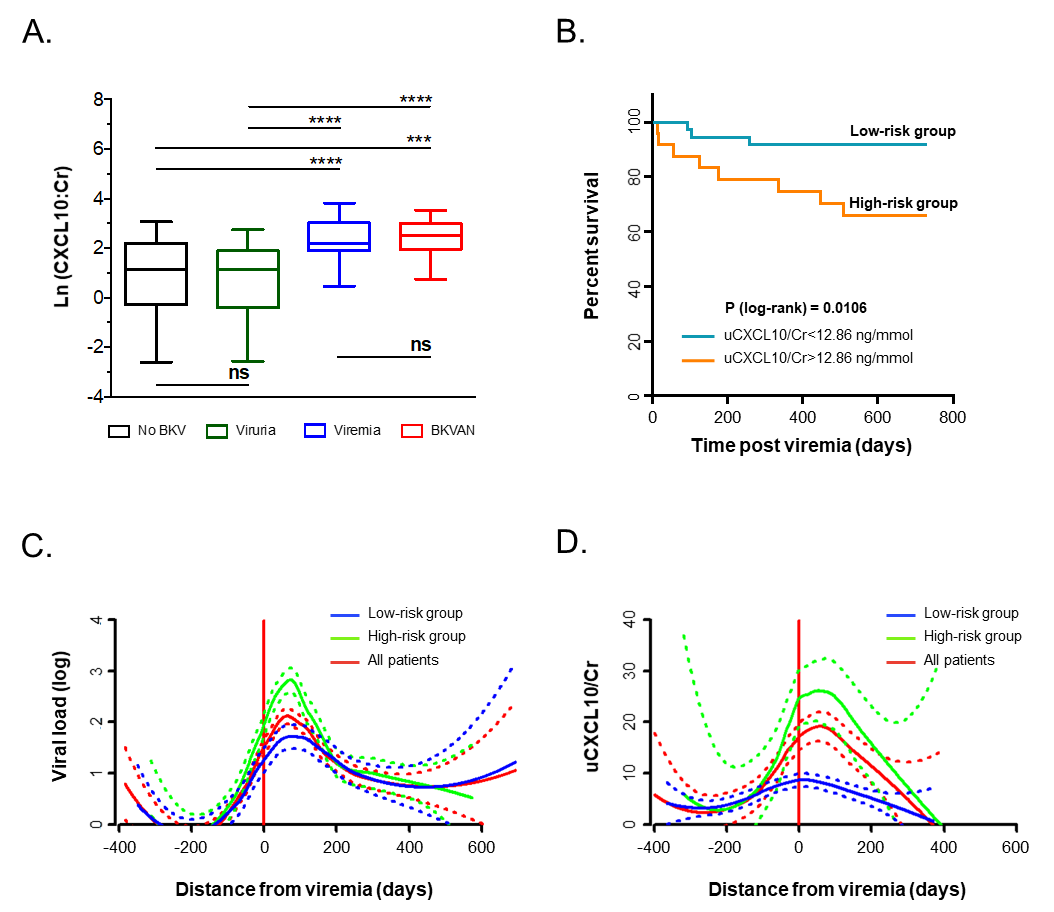Urinary CXCL10: From Diagnosis to Prediction of BK Viremia in Kidney Transplantation
1Kidney Transplantation, Inserm U1151, Necker Hospital, Paris, France, 2Pathology, Necker Hospital, Paris, France
Meeting: 2020 American Transplant Congress
Abstract number: A-313
Keywords: Non-invasive diagnosis, Polyma virus, Renal function
Session Information
Session Name: Poster Session A: Biomarkers, Immune Assessment and Clinical Outcomes
Session Type: Poster Session
Date: Saturday, May 30, 2020
Session Time: 3:15pm-4:00pm
 Presentation Time: 3:30pm-4:00pm
Presentation Time: 3:30pm-4:00pm
Location: Virtual
*Purpose: Urinary CXCL10 (uCXCL10) has proved to be a useful tool for the non-invasive diagnosis of acute rejection in kidney transplant recipients (KTRs). Upon development, BK virus (BKV) reactivation has repeatedly been identified as a confounding factor, i.e. a cause of increased level of uCXCL10 . Here, we refined CXCL10 levels across different stages of BKV replication and specifically investigated its potential as a prognostic and predictive biomarker in the course of BK reactivation.
*Methods: Quantification of CXCL10 was performed in a cross-sectional study including 391 urine samples from 330 patients collected at the time of a biopsy and a blood BK virus assessment. We categorized samples into four non-overlapping groups according to their BKV status: no BKV reactivation group (N=217), viruria group (N=112), if only viruria was detectable (negative BKV viremia and no BKV-associated nephritis (BKVAN)), viremia group (N=39), if BKV viremia was positive (no BKVAN on biopsy) and BKVAN group (N=23), if SV40 staining was positive and/or viral inclusion were seen on biopsy. Finally, the course of uCXCL10 throughout BKV status was studied in a longitudinal study of 5042 urine samples serially collected during the first post-transplant year in 258 KTRs.
*Results: Compared to no BKV reactivation samples, isolated BKV viruria had similar uCXCL10 levels (P=0.55) while BKV viremia, with or without BKVAN, significantly and similarly increased uCXCL10 levels (P<0.0001, Panel A). In viremic patients, uCXCL10 at the time of biopsy was significantly associated with the loss of 50% of estimated glomerular filtration rate at 2 years in a Cox model (Panel B, HR=1.65, 95% CI [1.08-2.51], P=0.02), regardless of graft function (P=0.46), viral load (P=0.50) and the presence of a BKVAN (P=0.84). A threshold of 12.86 ng/mmol identified KTRs with an increased risk of eGFR worsening (log-rank P-Value=0.01). In the longitudinal study, the course of uCXCL10 paralleled BK blood viral load (Panel C-D). Patients crossed the uCXCL10 threshold in a median time of 32 days before first positive BKV viremia. At the time of biopsy, when this cohort was split according to the uCXCL10 threshold, the high-risk group experienced higher pic viral load (2.8 vs 1.7, P<0.0001), and higher pic of uCXCL10 (27 vs 8.7, P<0.0001).
*Conclusions: In KTRs, uCXCL10 is significantly elevated at the time of a BKV viremia with or without BKVAN, but not in isolated viruria. A threshold of 12.86 ng/mL at the time of biopsy predicted a higher pic BKV viral load and graft dysfunction.
To cite this abstract in AMA style:
Tinel C, Vermorel A, Picciotto D, Morin L, Legendre C, Rabant M, Anglicheau D. Urinary CXCL10: From Diagnosis to Prediction of BK Viremia in Kidney Transplantation [abstract]. Am J Transplant. 2020; 20 (suppl 3). https://atcmeetingabstracts.com/abstract/urinary-cxcl10-from-diagnosis-to-prediction-of-bk-viremia-in-kidney-transplantation/. Accessed December 19, 2025.« Back to 2020 American Transplant Congress

